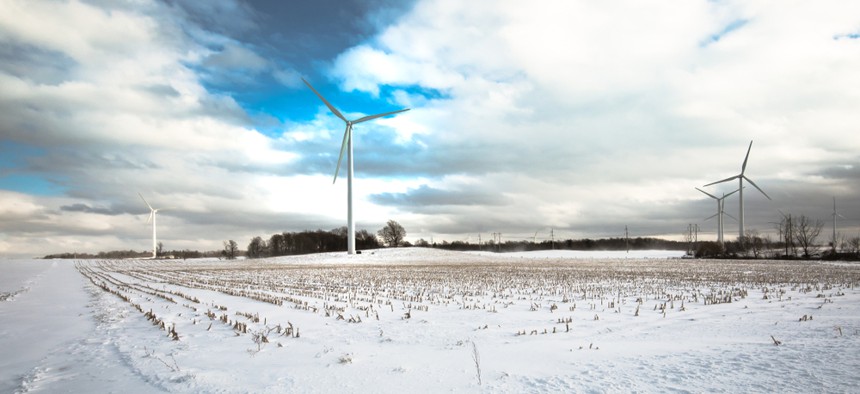Two nights before Thanksgiving, over 100 Tompkins County residents, some toting frozen turkeys they’d just purchased for the holiday, packed a hearing room in downtown Ithaca.
A resolution was on the county legislature’s agenda that opposed repowering a coal-burning power plant.
The Eisenhower-era Cayuga Power Plant in Lansing, one of the last coal-burning plants in the state, is seeking approval from the state Department of Environmental Conservation to convert from burning coal to burning natural gas.
The resolution before the 14 members of the Tompkins County Legislature opposed the conversion because a natural gas plant would increase methane emissions and continue pumping carbon into the atmosphere.
One of the speakers that night, Sandra Steingraber, a biologist and distinguished scholar in residence at Ithaca College, urged legislators to read the recently issued report from the U.N. Intergovernmental Panel on Climate Change. “What it tells us is that methane is a more powerful greenhouse gas than previously appreciated and that natural gas infrastructure, including power plants, leak a lot more than previously known,” she said.
Despite the strong probability of job losses, a hit to county tax revenue and the widely accepted notion that natural gas burns cleaner than coal, legislators voted 12-2 in favor of the nonbinding resolution.
They received a standing ovation.
New York only uses 3 percent wind energy and 1 percent solar energy.
The timing of the vote is notable. It came just over a month before the start of the 2019 legislative session in Albany.
While the Tompkins County resolution represents a victory for climate activism, there is a piece of legislation in Albany that would, in practice, mandate statewide what the county lawmakers called for.
The Climate and Community Protection Act, sponsored by state Sen. Brad Hoylman and Assemblyman Steve Englebright, is an expansive bill that requires New York state to generate 50 percent of its electricity from renewable energy by 2030. By 2050, the bill would require the elimination of all greenhouse gas emissions.
The bill is process-oriented. Baked into the plan is a climate action playbook that proponents say will guide the state from its current level of fossil fuel use down to zero.
For workers who may be displaced by the proposed transition to renewables, the bill includes prevailing wage standards and addresses the needs of environmental justice communities where many fossil fuel plants are currently located. The bill is, in one activist’s words, “a B-12 shot for the state’s renewables.”
Currently, New York only uses 3 percent wind energy and less than 1 percent from solar energy. “This is the most important issue on Earth,” said Englebright, who chairs the Assembly Committee on Environmental Conservation. “States now have to pick up the slack that has been created by the inaction of the federal government.”
State Sen. Todd Kaminsky, who was recently tapped to chair the state Senate’s Environmental Conservation Committee starting in January, agreed. “There is no doubt we need to take aggressive steps to address climate change,” he said. “This bill will be the central vehicle by which we will accomplish that.”
Peter Iwanowicz, executive director of Environmental Advocates of New York, said the state needs a strong foundation for setting its clean energy goals in law. “Right now the goals don’t exist in law,” he said. “They are at the whim of the executive.”
Iwanowicz is referring to an executive order Gov. Andrew Cuomo signed in 2017, as well as the state’s 2015 Energy Plan, both of which articulated New York’s aspirational goals to reduce greenhouse gas emissions by 40 percent by 2030 and 80 percent by 2050 from 1990 levels.
“Because the goals don’t exist in law, it’s hard for businesses to write a plan of how to create opportunities,” Iwanowicz said. “Surety in law is surety to businesses.”
Other states have already provided the business community with that certainty.
In September, California enshrined a commitment to move to 100 percent carbon-free electricity by 2045, something the state has been working toward since 2002. In 2008, Massachusetts enacted the Global Warming Solutions Act to reduce greenhouse gas emissions.
“When other states have passed similar laws it reorients all state decision-making to be consistent with achieving these goals,” Iwanowicz said. “You don’t have the schizophrenic nature of state government that you have in many of these places where they end up approving dirty projects when they should be aligned towards clean.”
New York is showing signs of that schizophrenia. In 2017, the same year Cuomo issued an executive order aspiring to a carbon-free future, the New York Power Authority, whose trustees are appointed by Cuomo, requested proposals for a natural gas turbine project to power the state Capitol complex. This year, the state Department of Environmental Conservation indicated it will likely approve the burning of plastics and other solid waste at a cement plant in Glens Falls, just north of Albany.
If the Climate and Community Protection Act is passed as currently written, those projects would not get state approval.
The the bill’s trajectory in Albany has taken a familiar route. Like other pieces of progressive legislation sponsored by Democrats, it has passed multiple times in the Assembly, and next year looks to be no exception. When asked in early December by WCNY if he will support the bill in the next session, Assembly Speaker Carl Heastie, a Democrat, said, “absolutely.”
But in the state Senate, the the bill has never moved out of committee. State Sen. Tom O’Mara, a Republican who chairs the Environmental Conservation Committee, is not a supporter of the bill, though he acknowledges climate change is a problem.
“Everybody is concerned about greenhouse gas emissions and climate change and this (bill) is a huge step down the road of the elimination of greenhouse gas emissions,” he said. “The real question is how feasible it is, and at what cost. It’s eliminating emissions, 100 percent, which just doesn’t seem feasible to me certainly in this short of a period of 30 years or less.”
Come January, O’Mara will cede the chairmanship to Kaminsky, one of the bill’s sponsors, and will therefore no longer have the power to prevent the bill from moving to the floor for a vote.

That worries Gavin Donohue, president and CEO of Independent Power Producers of New York Inc., a statewide trade association that represents independent electric power producers. “We’re very worried about the legislation, certainly with the new dynamic in the Senate,” he said.
Unlike other industry sectors, Donohue’s members have been required to meet carbon reduction goals set by the 2016 Clean Energy Standard, which was mandated by the state Public Service Commission. The key difference between the 2016 Clean Energy Standard and the 2015 State Energy Plan is that the former is a mandate and the latter is not.
Specifically, the Clean Energy Standard requires 50 percent of New York’s electricity come from renewable sources like wind and solar by 2030. This is mandatory and enforceable, and only applies to the power sector, which Donohue said is already achieving its goals.
He cites the state Energy Research and Development Authority’s Patterns and Trends 2017 report as proof. NYSERDA’s research indicates the power sector has already reduced greenhouse gas emissions by 53.8 percent since 1990 levels. The same chart shows greenhouse gas emissions from the transportation sector have grown 22.2 percent during the same time period.
To highlight what he views as inequitable treatment, Donohue lists the state regulatory requirements his industry sector is expected to meet.
“We have a CO2 performance standard. We have acid rain regulation. We have the Regional Greenhouse Gas Initiative. We have something coming out of the Department of Environmental Conservation on high electricity demand days that will impact all NYC generators,” Donohue said. “The other sectors that are making the largest contributions to CO2 have not had the same attention.”
One Democratic lawmaker who is watching the legislation closely agrees with Donohue that all industry sectors should work in concert toward meeting the state’s carbon reduction goals. “What about airplanes? What about buildings? What about transportation?” said the lawmaker, who would only speak on the condition of anonymity. The lawmaker said that the bill may have to be tweaked and raised concerns about relying too heavily on the state Department of Environmental Conservation alone to regulate the energy industry.
Anne Reynolds, the executive director of Alliance for Clean Energy New York, which represents the renewable energy industry, has an entirely different concern. While she said the Climate and Community Protection Act “takes an economywide approach” and that her organization would be “happy if it passed,” she is more worried about the sluggishness of the state’s approval process for large-scale renewable energy projects.
“We need something to help renewables investments in the shorter term,” she said. “In the real world in New York, we’re having trouble getting projects sited.”
Currently, the state Public Service Commission has only approved one renewable energy project under the siting board that reviews them.
There are two reasons for the clogged system, according to Reynolds. “The state’s siting process, designed for traditional power plants, is too long and cumbersome,” she said. “New York’s goals require a major acceleration of wind and solar construction, but the state has the same number of people processing applications and that just doesn’t add up.”
The greatest challenge to the bill will likely come from the business community. Darren Suarez, director of government affairs at The Business Council of New York State, acknowledged the need to reduce greenhouse gas emissions. But in an email, he stated unequivocally that “the Climate and Community Protection Act will not reduce our future risks from climate change.” Suarez said the technology is not currently available to meet the requirements of the legislation without hurting the state’s economy.
Iwanowicz strongly disagreed. “Every time I’m on the Mass Pike, and I mean this literally, I see more energy projects being built along the rights of way of the Mass Pike and on the lands adjacent to it. They are going gangbusters for solar. And the reason is their commitments are already in law.”
Every time I’m on the Mass Pike, I see more energy projects being built. They are going gangbusters for solar. And the reason is their commitments are already in law. – Peter Iwanowicz, Environmental Advocates of New York executive director
The latest National Climate Assessment released in November makes it clear that climate change is going to be enormously expensive, no matter how the state decides to address it.
Investments in new technology like geothermal and battery storage will be costly and will result in worker displacement and economic disruption as the state transitions off fossil fuels. But the costs that come from doing nothing in response to climate change will be much greater.
Still, the climate bill is going to be a tough sell, politically. Veteran Albany political strategist Bruce Gyory recognized that there is a “practical, economic and moral imperative to deal with climate change.” But he points to concerns that the new Democratic majority in the state Senate could be vulnerable.
“You have to be cautious about how the bill impacts those marginal members in the suburbs and upstate, especially in the Senate,” he warned. “Are you unwittingly triggering something that could be labeled a tax?”
While all the stakeholders contacted for this article believe that humans are contributing to global warming, they are at odds over how aggressively to address the issue and who should act.
In her testimony to the Tompkins County Legislature in November, biologist Sandra Steingraber made an uncomfortable observation, one that will likely be remembered this coming session in Albany: “Hard sacrifices lie ahead. But they become bigger the longer they are delayed.”


